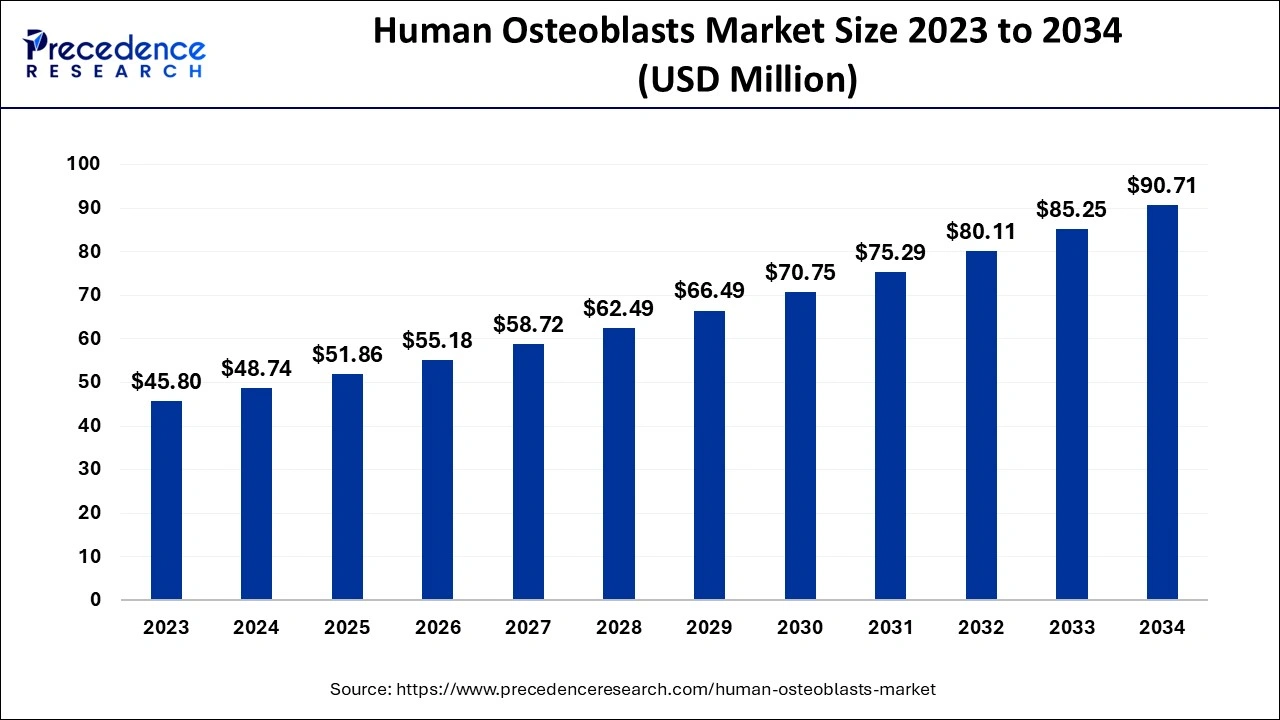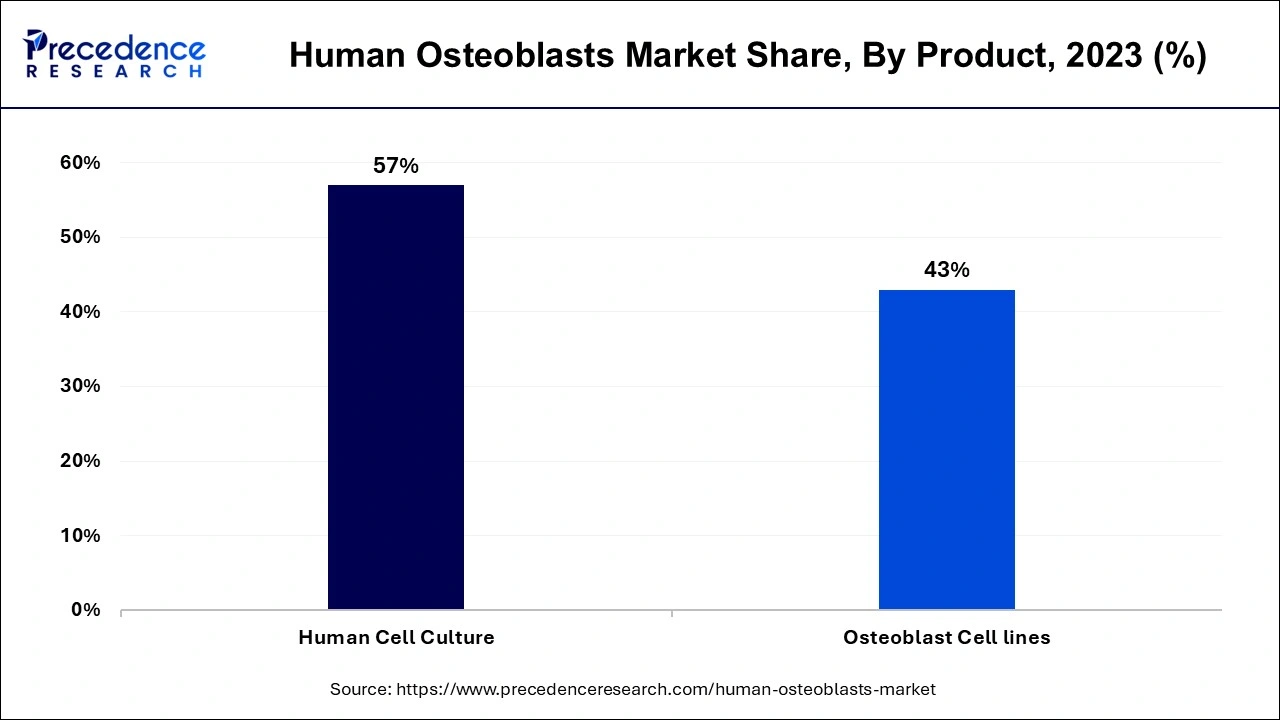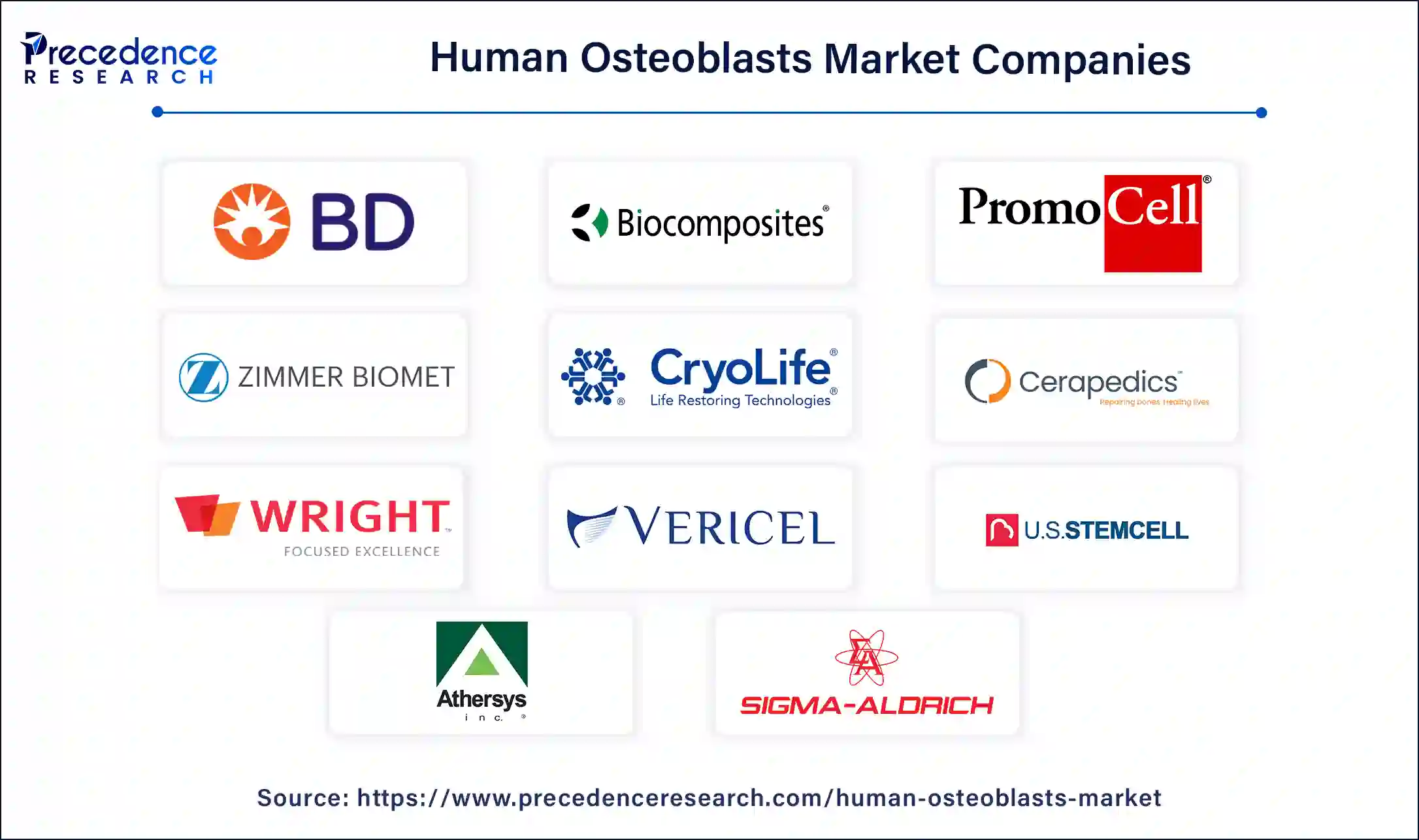December 2024
The global human osteoblasts market size accounted for USD 48.74 million in 2024, grew to USD 51.86 million in 2025 and is expected to be worth around USD 90.71 million by 2034, registering a CAGR of 6.41% between 2024 and 2034.
The global human osteoblasts market size is calculated at USD 48.74 million in 2024 and is projected to hit around USD 90.71 million by 2034, expanding at a CAGR of 6.41% from 2024 to 2034. The human osteoblasts market is driven by the rapidly growing geriatric population worldwide.

The market for human osteoblasts is important to many industries, but especially to biotechnology, pharmaceuticals, regenerative medicine, and orthopedic research. In regenerative medicine, osteoblasts are essential, especially when creating bioengineered bone structures. The market fosters developments in stem cell research by providing osteoblast-based models to comprehend differentiation and encourage the use of stem cells in bone regeneration. To treat bone loss brought on by aging, trauma, or cancer therapies, this is important.
The success of dental and orthopedic implants depends on osteoblasts. The materials used in implants are improved by research on osteoblast activity and function, which guarantees greater integration with the bone, lowers rejection, and lengthens implant longevity.
How is AI helping Human Osteoblasts Market Growth?
Large datasets are being used to train artificial intelligence models, namely machine learning (ML) algorithms, to forecast how osteoblasts would behave in diverse scenarios and differentiate from progenitor cells. AI can assist in predicting which factors encourage or inhibit osteoblast differentiation, resulting in improved bone regeneration procedures, by examining gene expression profiles, epigenetic data, and molecular signaling networks. AI makes individualized methods of bone healing possible by using patient-specific data to customize treatment programs.
| Report Coverage | Details |
| Market Size by 2034 | USD 90.71 Million |
| Market Size in 2024 | USD 48.74 Million |
| Market Size in 2025 | USD 51.86 Million |
| Market Growth Rate from 2024 to 2034 | CAGR of 6.41% |
| Largest Market | North America |
| Base Year | 2023 |
| Forecast Period | 2024 to 2034 |
| Segments Covered | Product, Application, End user, and Regions |
| Regions Covered | North America, Europe, Asia-Pacific, Latin America, and Middle East & Africa |
Growing prevalence of bone-related disorders
One of the most prominent bone-related conditions, osteoporosis, is more common in older persons, especially in postmenopausal women. It raises the risk of fractures and results in decreased bone density. Over 200 million individuals worldwide have osteoporosis, and millions more are at risk, according to the International Osteoporosis Foundation. The number of people afflicted by this ailment is expected to increase as the world's population ages. For individuals with significant bone loss, for instance, researchers are attempting to stimulate osteoblast development from stem cells to build new bone tissue. Osteoblasts are an essential tool in tackling the rising burden of bone-related disorders because of the latest treatment approaches brought about by our improving understanding of bone biology and osteoblast function.
Increasing focus on personalized medicine
The increased attention paid to genomics has made possible the discovery of genetic markers that affect bone density, metabolism, and the general capacity of bone tissue to repair. Genetic profiling is used in personalized medicine to assess a person's osteoporosis or bone fracture risk. This has increased the effectiveness of using human osteoblasts in regenerative treatments by enabling the development of therapies tuned to the patient's genetic composition. By modifying osteoblasts generated from the individual's cells to target specific genetic defects or deficiencies, precision therapy for conditions impacting bone production can be delivered.
Lack of skilled professionals
Developments in osteoblast biology are frequently necessary for creating bone regeneration therapies, such as those for osteoporosis or bone injuries. However, therapeutic advancements may be postponed without qualified researchers capable of planning, carrying out, and interpreting studies on osteoblast behavior, development, and function. Surgeons, doctors, and other medical experts who are knowledgeable about the biological characteristics of osteoblasts and the technical needs of the procedures are needed when using them in clinical settings for regenerative therapies such as bone grafts or implants. The effective use of these cutting-edge medicines may be hindered by a shortage of skilled professionals, which would lower patient access and treatment results.
Advances in tissue engineering
With the development of bone-on-a-chip technology, osteoblasts are cultivated in a controlled, miniature environment that replicates the mechanical and chemical characteristics of bone thanks to advancements in microfluidic systems. Disease modeling and high-throughput drug screening are two applications for these chips. To provide these platforms for drug testing, particularly for bone-related disorders, companies that specialize in lab-on-a-chip devices or cell-based assays employing osteoblasts can look into partnering with biotech and pharmaceutical companies.
The human cell culture segment dominated the human osteoblasts market in 2023. In research on bone regeneration, skeletal abnormalities, and different treatments for bone-related ailments, osteoblasts, the cells that make bones, are essential. Human cell cultures are a vital research tool because they offer a controlled environment for comprehending the behavior of these cells, particularly osteoblast cultures. These cultures are used by pharmaceutical companies to more accurately forecast how osteoblasts would behave biologically in response to medications or other therapeutic approaches. The demand for osteoblast cell cultures has increased dramatically due to this broad use, making this market a key component of drug development initiatives about bone health.

The osteoblast cell lines segment shows a notable growth in the human osteoblasts market during the forecast period. The advancement of 3D cell culture methods helps to increase the osteoblast cell lines segment. 3D cell cultures provide a more realistic depiction of bone tissue than traditional 2D cell cultures, which are limited in replicating the bone microenvironment. This development enables researchers to test possible treatments in a more physiologically realistic environment and more accurately replicate bone ailments. Osteoblast cell lines become more useful in drug testing and bone biology research when 3D culture platforms are integrated.
The regeneration surgeries segment dominated the human osteoblasts market in 2023. The need for regeneration procedures has increased because of the rise in bone fractures, degenerative bone disorders, and other skeletal problems. Because they aid in the spontaneous repair and regeneration of bone structures, human osteoblasts, crucial for bone formation, are necessary for these operations. Human osteoblasts are increasingly employed in dentistry and maxillofacial surgical fields to treat facial bone fractures and abnormalities and help bone growth in the jaw for dental implants. The widespread usage of these procedures has further boosted the market for regeneration surgeries due to their effectiveness.
The hospital segment dominated the human osteoblasts market in 2023. Since human osteoblasts oversee bone growth and regeneration, they are essential for treating bone problems. High patient volumes with disorders including fractures, osteoporosis, and other degenerative bone diseases are seen in hospitals, especially those with dedicated orthopedic and trauma care departments. Since they have adopted innovative therapies and products that involve human osteoblasts, hospitals are now influential buyers in the sector. They are also essential for the post-operative care and rehabilitation of patients undergoing bone regeneration treatments.
After surgery, human osteoblasts play a critical role in the healing process, particularly for bone transplants and fractures. Hospitals, which provide long-term care and rehabilitation services, are the main suppliers of these therapies, which raises the demand for human osteoblasts.
North America dominated the human osteoblasts market in 2023. The cost of healthcare per person in the U.S. is among the highest in the world. The osteoblast market immediately benefits from the large amount of this expenditure that is devoted to musculoskeletal problem research, diagnosis, and therapy. In North America, 3D bioprinting technological advancements are common and allow for the production of bone grafts that contain osteoblasts.
Canada and the United States held a significant share of the human osteoblasts market in 2023. North America, particularly the U.S., has a strong regulatory framework. Several osteoblast-based therapies and devices have gained FDA approval, boosting market confidence and adoption. Biotech and pharmaceutical companies are launching new osteoblast-focused products in the region, catering to the growing demand for innovative bone therapies.
Asia-Pacific is observed to be the fastest growing in human osteoblasts market during the forecast period. Asia-Pacific's biopharmaceutical industry is expanding rapidly as a result of the region's growing need for the latest therapies and rising healthcare expenses. Countries like China are becoming more and more important in the production and study of biopharmaceuticals. This increase makes the development and commercialization of osteoblast-related products, including scaffolds, cell-based therapies, and bone transplants, easier.

Segments Covered in the Report
By Product
By Application
By End user
By Geography
For inquiries regarding discounts, bulk purchases, or customization requests, please contact us at sales@precedenceresearch.com
No cookie-cutter, only authentic analysis – take the 1st step to become a Precedence Research client
December 2024
November 2024
November 2024
March 2025